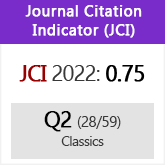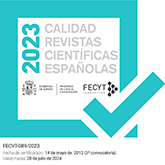Del proto-indoeuropeo a ipse e iste en latín arcaico: ¿Dos caras de la misma moneda?
DOI:
https://doi.org/10.3989/emerita.2021.10.2035Palabras clave:
proto-indoeuropeo, latín arcaico, jerarquía referencial, demostrativosResumen
Este trabajo presenta un análisis comparativo de ipse e iste en latín arcaico. Nuestro objetivo es explicar las diferencias y similitudes entre ipse e iste a partir de un origen común parcial en PIE. Para esto, analizamos la distribución de estos pronombres según diversos rasgos gramaticales, semánticos y pragmáticos. La distribución desigual de ipse e iste sugiere que estos derivan de elementos ubicados en diferentes puntos de una jerarquía referencial. Considerando evidencia interlingüística, estos datos pueden interpretarse como la preservación residual de un sistema que marcaba argumentos proximativos y obviativos en PIE.
Descargas
Citas
Álvarez, O. (2009): «Pronombres», in Baños, J. (coord.), Sintaxis del latín clásico, Madrid, Liceus, pp. 273-297.
Bailey, C. (1940): «Old Roman Religious Texts», The Classical Review 54, pp. 44-46. https://doi.org/10.1017/S0009840X00096700
Bassols, M. (1992): Sintaxis latina, 10a ed., Madrid, CSIC.
Beekes, R. & de Vaan, M. (2011): Comparative Indo-European Linguistics. An Introduction. Second Edition, Revised and Corrected by Michiel de Vaan, Amsterdam, Benjamins.
Berenguer, J. A. (1998): «La heteróclisis IE *SO/*TO», Emerita 66, pp. 257-290. https://doi.org/10.3989/emerita.1998.v66.i2.258
Berenguer, J. A. (2000): Estudio sobre las partículas indoeuropeas con base consonántica y laringal, Madrid, CSIC.
Bickel, B. (2011): «Grammatical Relations Typology», in Song, J. (ed.), The Oxford Handbook of Language Typology, Oxford, Oxford University Press, pp. 399-444. https://doi.org/10.1093/oxfordhb/9780199281251.013.0020
Cennamo, M. (1993): The Reanalysis of Reflexives: A Diachronic Perspective, Naples, Liguori.
de Melo, W. (2010): «Morfosintassi latina. Punti di vista by N. La Fauci; S. Pieroni». Mnemosyne 63 (2), pp. 336-340. https://doi.org/10.1163/156852510X496062
de Vaan, M. (2008): Etymological Dictionary of Latin and the Other Italic Languages, Leiden-Boston, Brill.
de Vaan, M. (2013): «Reduplicated Demonstratives in Ancient Indo-European Languages», Transactions of the Philological Society 113 (1), pp. 38-52. https://doi.org/10.1111/1467-968X.12038
de Vries, L. (1995): «Demonstratives, Referent Identification and Topicality in Wambon and Some Other Papuan Languages», Journal of Pragmatics 24, pp. 513-533. https://doi.org/10.1016/0378-2166(94)00068-P
Dunkel, G. (2014): Lexikon der indogermanischen Partikeln und Pronominalstämme, Heidelberg, Universitätsverlag Winter.
Dupraz, E. (2012): Sabellian Demonstratives: Forms and Functions, Leiden-Boston, Brill. https://doi.org/10.1163/9789004216990
Ferraresi, G. (1996): «Middles, Reflexives, and Ergatives in Gothic», in Brandner, E. & Ferraresi, G. (eds.), Language Change and Generative Grammar, Opladen, Westdeutscher Verlag, pp. 273-291. https://doi.org/10.1007/978-3-322-90776-9_11
Fortson, B. (2004): Indo-European Language and Culture. An Introduction, Oxford, Blackwell.
Fortson, B. (2011): «The Historical Background to Latin Within the Indo-European Language Family», in Clackson, J. (ed.), A Companion to Latin Language, Chichester, Wiley-Blackwell, pp. 199-219. https://doi.org/10.1002/9781444343397.ch13
Golluscio, L. & Hasler, F. (2017): «Jerarquías referenciales y alineamiento inverso en mapudungun», RASAL lingüística 1, pp. 69-93.
Griffith, A. (2018): «Diachrony and the Referential Hierarchy in Old Irish», in Cristofaro, S. & Zúñiga, F. (eds.) Typological Hierarchies in Synchrony and Diachrony, Amsterdam, Benjamins. https://doi.org/10.1075/tsl.121.05gri
Haude, K. & Witzlack-Makarevich, A. (2016): «Referential Hierarchies and Alignment: An Overview», Linguistics 54, pp. 433-441. https://doi.org/10.1515/ling-2016-0008
Jacques, G. & Antonov A. (2014): «Direct / Inverse Systems», Language and Linguistics Compass 8, pp. 301-318. https://doi.org/10.1111/lnc3.12079
König, E. & Gast V. (2006): «Focused Expressions of Identity: A Typology of Intensifiers», Linguistic Typology 10 (2), pp. 223-276. https://doi.org/10.1515/LINGTY.2006.008
Luján, E. & Mendoza, J. (2019): «La externalización de la flexión en los pronombres indoeuropeos y el alargamiento *-sm», Revista Española de Lingüística 49 (1), pp. 235-266. https://doi.org/10.31810/RSEL.49.10
Luraghi, S. (2011): «The origin of the Proto-Indo-European Gender System: Typological Considerations», Folia Linguistica 45, pp. 435-464. https://doi.org/10.1515/flin.2011.016
Meiser, G. (1998): Historische Laut- und Formenlehre der lateinischen Sprache, Darmstadt, Wissenschaftliche Buchgesellschaft.
Mendoza, J. (1998): «Pronombres, adverbios y partículas», in Rodríguez Adrados, F., Bernabé, A. & Mendoza, J. (eds.) Manual de lingüística indoeuropea, vol. III, Madrid, Ediciones Clásicas, pp. 3-124.
Monteil, P. (2003): Elementos de fonética y morfología del latín, Sevilla, Universidad de Sevilla.
Norden, E. (1939): Aus altrömischen Priestbüchern, Lund, Gleerup.
Orqueda, V. & Toro, F. (2020): «Diachronic Development of Functions of se and sibi in Latin», SLE Digital Conference, 26 Aug - 1Sept.
Petit, D. (1999): *Sue- en grec ancien: La famille du pronom réfléchi: Linguistique grecque et comparaison indo-européenne, Louvain, Peeters.
Pieroni, S. (2010): «Deixis and Anaphora», in Baldi, P. & Cuzzolin, P.L. (eds.), New Perspectives on Historical Latin Syntax, vol. 3, Berlin-New York, De Gruyter, pp. 389-501. https://doi.org/10.1515/9783110215465.389
Pinkster, H. (2015): The Oxford Latin Syntax: Volume 1: The Simple Cause, Oxford, Oxford University Press. https://doi.org/10.1093/acprof:oso/9780199283613.003.0001
Pisani, V. (1945): Lezioni sulla preistoria e storia più antica del latino, Milán, Vita e Pensiero.
Pooth, R. (2018): Transitivity Direction in Proto-Indo-European: Direct, Inverse, and Undirected Verb Forms. Unpublished manuscript <https://www.academia.edu/37429692/Transitivity_Direction_in_Proto-Indo-European_Direct_Inverse_and_Undirected_Verb_Forms> (30/05/2020).
Pooth, R., Kerkhof, P. A., Kulikov, L. & Bar›dal, J. (2019): «The Origin of Non-Canonical Case Marking of Subjects in Proto-Indo-European: Accusative, Ergative, or Semantic Alignment», Indogermanische Forschungen 123, pp. 245-263. https://doi.org/10.1515/if-2019-0009
Puddu, N. (2005): Riflessivi e intensificatori: greco, latino e le altre lingue indoeuropee, Pisa, ETS.
Rumsey, A. (1987): «The Chimera of Proto-Indo-European Ergativity», Lingua 71, pp. 297-318. https://doi.org/10.1016/0024-3841(87)90076-3
Schmidt, G. (1978): Stammbildung und Flexion der indogermanischen Personalpronomina, Wiesbaden, Harrassowitz.
Siewierska, A. (1998): «Passive-to-ergative versus inverse-to-ergative», in Siewierska, A. & Song, J. (eds.), Case, Typology and Grammar, Amsterdam, John Benjamins, pp. 229-246. https://doi.org/10.1075/tsl.38.14sie
Sihler, A. L. (1995): New Comparative Grammar of Greek and Latin, Oxford, Oxford University Press.
Silverstein, M. (1976): «Hierarchy of Features and Ergativity», in Dixon, R. (ed.), Grammatical Categories in Australian Languages, New Jersey, Humanities Press, pp. 112-171.
Sturtevant, E. H. (1939): «The Pronoun *so, *sa, *tod and the Indo-Hittite Hypothesis», Language 15, pp. 11-19. https://doi.org/10.2307/409404
Szemerényi, O. (1978): Introducción a la lingüística comparativa (transl. Álvarez, A.), Madrid, Gredos.
Weiss, M. L. (2009): Outline of the Historical and Comparative Grammar of Latin, Ann Arbor-New York, Beech Stave Press.
Wolfart, H. (1973): «Plains Cree: A Grammatical Study», Transactions of the American Philosophical Society 63 (5), pp. 1-90. https://doi.org/10.2307/1006246
Zamudio, R. (1989): «La forma pronominal latina ipse: su origen», Emerita, 57, pp. 119-127. https://doi.org/10.3989/emerita.1989.v57.i1.582
Zúñiga, F. (2007): «From the Typology of Inversion to the Typology of Alignment», in Miestamo, M. & Wälchli, B. (eds.), New Challenges in Typology: Broadening the Horizons and Redefining the Foundations, Berlin-New York, De Gruyter, pp. 199-221.
Descargas
Publicado
Cómo citar
Número
Sección
Licencia
Derechos de autor 2021 Consejo Superior de Investigaciones Científicas (CSIC)

Esta obra está bajo una licencia internacional Creative Commons Atribución 4.0.
© CSIC. Los originales publicados en las ediciones impresa y electrónica de esta Revista son propiedad del Consejo Superior de Investigaciones Científicas, siendo necesario citar la procedencia en cualquier reproducción parcial o total.Salvo indicación contraria, todos los contenidos de la edición electrónica se distribuyen bajo una licencia de uso y distribución “Creative Commons Reconocimiento 4.0 Internacional ” (CC BY 4.0). Puede consultar desde aquí la versión informativa y el texto legal de la licencia. Esta circunstancia ha de hacerse constar expresamente de esta forma cuando sea necesario.
No se autoriza el depósito en repositorios, páginas web personales o similares de cualquier otra versión distinta a la publicada por el editor.














